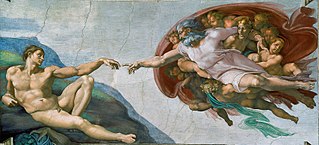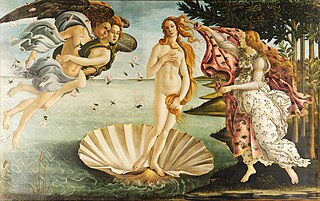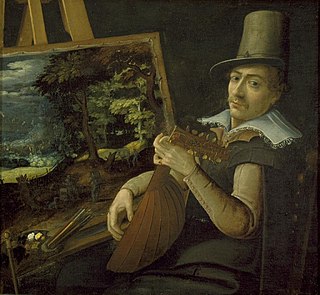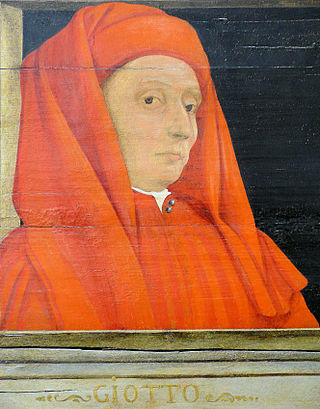
Fresco is a technique of mural painting executed upon freshly laid ("wet") lime plaster. Water is used as the vehicle for the dry-powder pigment to merge with the plaster, and with the setting of the plaster, the painting becomes an integral part of the wall. The word fresco is derived from the Italian adjective fresco meaning "fresh", and may thus be contrasted with fresco-secco or secco mural painting techniques, which are applied to dried plaster, to supplement painting in fresco. The fresco technique has been employed since antiquity and is closely associated with Italian Renaissance painting.

Gaius Plinius Secundus, known in English as Pliny the Elder, was a Roman author, naturalist, natural philosopher, and naval and army commander of the early Roman Empire, and a friend of the emperor Vespasian. He wrote the encyclopedic Naturalis Historia, a comprehensive thirty-seven-volume work covering a vast array of topics on human knowledge and the natural world, which became an editorial model for encyclopedias. He spent most of his spare time studying, writing, and investigating natural and geographic phenomena in the field.

Taddeo Zuccaro was an Italian painter, one of the most popular members of the Roman mannerist school.

The Birth of Venus is a painting by the Italian artist Sandro Botticelli, probably executed in the mid 1480s. It depicts the goddess Venus arriving at the shore after her birth, when she had emerged from the sea fully-grown. The painting is in the Uffizi Gallery in Florence, Italy.

The Domus Aurea was a vast landscaped complex built by the Emperor Nero largely on the Oppian Hill in the heart of ancient Rome after the great fire in 64 AD had destroyed a large part of the city.

The Great Fire of Rome began on the 18th of July 64 AD. The fire started in the merchant shops around Rome's chariot stadium, Circus Maximus. After six days, the fire was brought under control, but before the damage could be assessed, the fire reignited and burned for another three days. In the aftermath of the fire, 71% of Rome had been destroyed.

The art of Ancient Rome, and the territories of its Republic and later Empire, includes architecture, painting, sculpture and mosaic work. Luxury objects in metal-work, gem engraving, ivory carvings, and glass are sometimes considered to be minor forms of Roman art, although they were not considered as such at the time. Sculpture was perhaps considered as the highest form of art by Romans, but figure painting was also highly regarded. A very large body of sculpture has survived from about the 1st century BC onward, though very little from before, but very little painting remains, and probably nothing that a contemporary would have considered to be of the highest quality.

The Baths of Titus or Thermae Titi were public baths (Thermae) built in 81 AD at Rome, by Roman emperor Titus. The baths sat at the base of the Esquiline Hill, an area of parkland and luxury estates which had been taken over by Nero for his Golden House or Domus Aurea. Titus' baths were built in haste, possibly by converting an existing or partly built bathing complex belonging to the reviled Domus Aurea. They were not particularly extensive, and the much larger Baths of Trajan were built immediately adjacent to them at the start of the next century.

Giovanni Nanni, also Giovanni de' Ricamatori, better known as Giovanni da Udine (1487–1564), was an Italian painter and architect born in Udine. A painter also named Giovanni da Udine was exiled from his native city in 1472.

Paul Bril was a Flemish painter and printmaker principally known for his landscapes. He spent most of his active career in Rome. His Italianate landscapes had a major influence on landscape painting in Italy and Northern Europe.

Amico Aspertini, also called Amerigo Aspertini, was an Italian Renaissance painter and sculptor whose complex, eccentric, and eclectic style anticipates Mannerism. He is considered one of the leading exponents of the Bolognese School of painting.

Iaia of Cyzicus, sometimes (incorrectly) called Lala or Lalla, or rendered as Laia or Maia, was a Greek painter born in Cyzicus, Roman Empire, and relatively exceptional for being a woman artist and painting women's portraits. She was alive during the time of Marcus Terentius Varro. In De Mulieribus Claris, his book of women's biographies, Boccaccio refers to her as "Marcia", possibly confusing her with the Vestal Virgin of that name. According to Pliny the Elder: "No one had a quicker hand than she in painting".

The Colossus of Nero was a 30-metre (98 ft) bronze statue that the Emperor Nero created in the vestibule of his Domus Aurea, the imperial villa complex which spanned a large area from the north side of the Palatine Hill, across the Velian ridge to the Esquiline Hill in Rome. It was modified by Nero's successors into a statue of the sun god Sol. The statue was eventually moved to a spot outside the Flavian Amphitheatre, which became known, by its proximity to the Colossus, as the Colosseum.

The Trinci Palace is a patrician residence in the center of Foligno, central Italy. It houses an archaeological museum, the city's picture gallery, a multimedia museum of Tournaments and Jousts and the Civic Museum.

The Domus Transitoria was Roman emperor Nero's first palace damaged or destroyed by the Great Fire of Rome in 64 AD, and then extended by his Domus Aurea.

Venetian painting was a major force in Italian Renaissance painting and beyond. Beginning with the work of Giovanni Bellini and his brother Gentile Bellini and their workshops, the major artists of the Venetian school included Giorgione, Titian, Tintoretto (1518–1594), Paolo Veronese (1528–1588) and Jacopo Bassano (1510–1592) and his sons. Considered to give primacy to colour over line, the tradition of the Venetian school contrasted with the Mannerism prevalent in the rest of Italy. The Venetian style exerted great influence upon the subsequent development of Western painting.

Giotto di Bondone, known mononymously as Giotto, was an Italian painter and architect from Florence during the Late Middle Ages. He worked during the Gothic and Proto-Renaissance period. Giotto's contemporary, the banker and chronicler Giovanni Villani, wrote that Giotto was "the most sovereign master of painting in his time, who drew all his figures and their postures according to nature" and of his publicly recognized "talent and excellence". Giorgio Vasari described Giotto as making a decisive break from the prevalent Byzantine style and as initiating "the great art of painting as we know it today, introducing the technique of drawing accurately from life, which had been neglected for more than two hundred years".

Peiraikos, or Piraeicus or Peiraeicus, was an Ancient Greek painter of uncertain date and location. He was the chief representative of what is called rhopography (ῥοπογραφία), or the painting of petty subjects, such as still-life. None of his work is known to have survived and he is known only from a brief discussion by the Latin author Pliny the Elder. Pliny's passage comes in the middle of his discussion of painting in Book XXXV of his Natural History, completed about 78 AD:
It is well to add an account of the artists who won fame with the brush in painting smaller pictures. Amongst them was Peiraikos. In mastery of his art but few take rank above him, yet by his choice of a path he has perhaps marred his own success, for he followed a humble line, winning however the highest glory that it had to bring. He painted barbers' shops, cobblers' stalls, asses, eatables and similar subjects, earning for himself the name of rhyparographos [painter of dirt/low things]. In these subjects he could give consummate pleasure, selling them for more than other artists received for their large pictures.

Augustan and Julio-Claudian art is the artistic production that took place in the Roman Empire under the reign of Augustus and the Julio-Claudian dynasty, lasting from 44 BC to 69 AD. At that time Roman art developed towards a serene "neoclassicism", which reflected the political aims of Augustus and the Pax Romana, aimed at building a solid and idealized image of the empire.

Painting in ancient Rome is a still poorly understood topic in the history of painting, as its study is hampered by the scarcity of relics. Much of what we know today about Roman painting is due to a natural tragedy. When the volcano Vesuvius erupted in AD 79 it buried two thriving cities, Pompeii and Herculaneum. Much of the population perished, but the buildings were partially preserved under the ashes and hardened lava, and with them their decorative wall paintings. From the study of this remaining collection, it has been possible to form a very suggestive panorama of the fertile and diverse artistic life of Ancient Rome between the end of the Republic and the beginning of the Empire, but this body of works is actually only a tiny fraction of the great quantity of painting produced in the entire Roman territory in the course of its long history, and precisely because this fraction is very rich, the loss of more significant and abundant testimonies from earlier and later periods, in techniques other than fresco and from other Romanized regions besides Campania is regrettable.




















